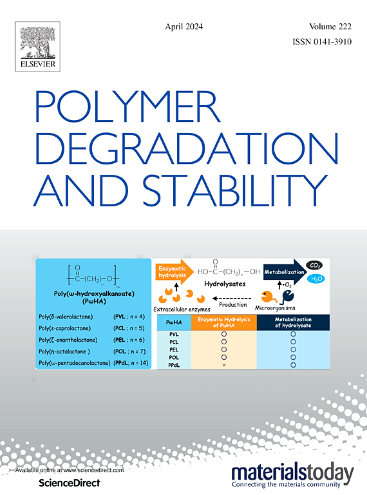Influence of surface chemical modifications on enhancing the aging behavior of capacitor biaxially-oriented polypropylene thin film
IF 6.3
2区 化学
Q1 POLYMER SCIENCE
引用次数: 0
Abstract
Modern power electronic systems require appropriate metallized polypropylene capacitors (MPCs) to operate in harsh environments. Due to their limited operating capabilities, commercial biaxially-oriented polypropylene (BOPP) films—the primary component of MPCs—are susceptible to degradation in high electric fields and at high temperatures. In order to enhance the aging behavior of BOPP, this work proposes one-sided phosphorylation at optimum and excessive acid concentrations of 8 % and 15 % for 24 hours at a [high] temperature of 60 °C. The proposed surface modifications' success in enhancing the aging behaviors of BOPP is confirmed by DC electrothermal aging. Field emission scanning electron microscopy (FE-SEM) analysis reveals changes in surface morphology resulting from phosphorylation. The changes in crystal structure of the original and phosphorylated samples are evaluated using X-ray diffraction (XRD). The average crystallite size, dislocation density, and microstrain during aging are also characterized using the Williamson-Hall (W-H) analysis method. Fourier transform infrared (FTIR) spectroscopy is used to identify changes in the chemical composition and functional groups resulting from phosphorylation and aging, while X-ray photoelectron spectroscopy (XPS) is used to analyze changes in the surface chemical elements of the original, phosphorylated, and aged samples. The charge-thermally stimulated discharge (C-TSD) technique and broadband dielectric spectroscopy (BDS) are used to verify the electrical performance. Mechanical properties, including thermal stability, are measured using the dynamic mechanical analysis (DMA) technique. The results indicated that the optimized phosphorylation improved the BOPP film's electrical and mechanical properties. As a result, the surface charge stability was found to increase under thermally stimulated discharge by 74 % and the dielectric constant by 2 %, while the dielectric losses decreased by 20.2 %. Under aging, for the first time, the dielectric constant was found to increase by 4.8 %, while dielectric losses decreased by 8.9 %. In return, deformation resistance, ductility, and lower energy dissipation demonstrated enhanced mechanical performance.

表面化学改性对提高电容器双轴取向聚丙烯薄膜老化性能的影响
现代电力电子系统需要适当的金属化聚丙烯电容器(mpc)在恶劣环境下运行。由于其有限的操作能力,商业双轴定向聚丙烯(BOPP)薄膜- mpcs的主要成分-在高电场和高温下容易降解。为了增强BOPP的老化行为,本研究提出在最佳和过量酸浓度为8%和15%的情况下,在60°C的[高]温度下进行24小时的片面磷酸化。直流电热老化实验证实了表面改性对BOPP老化性能的改善。场发射扫描电镜(FE-SEM)分析揭示了磷酸化引起的表面形貌变化。利用x射线衍射(XRD)分析了原始样品和磷酸化样品的晶体结构变化。采用Williamson-Hall (W-H)分析方法对时效过程中的平均晶粒尺寸、位错密度和微应变进行了表征。傅里叶变换红外光谱(FTIR)用于鉴定磷酸化和老化导致的化学成分和官能团的变化,而x射线光电子能谱(XPS)用于分析原始,磷酸化和老化样品表面化学元素的变化。利用电荷热激放电(C-TSD)技术和宽带介电光谱(BDS)技术对其电性能进行了验证。机械性能,包括热稳定性,使用动态力学分析(DMA)技术进行测量。结果表明,优化后的磷酸化处理改善了BOPP薄膜的电学和力学性能。结果表明,在热激放电条件下,表面电荷稳定性提高了74%,介电常数提高了2%,而介电损耗降低了20.2%。在老化条件下,首次发现介电常数增加了4.8%,而介电损耗减少了8.9%。反过来,变形抗力,延展性和较低的能量耗散证明了增强的机械性能。
本文章由计算机程序翻译,如有差异,请以英文原文为准。
求助全文
约1分钟内获得全文
求助全文
来源期刊

Polymer Degradation and Stability
化学-高分子科学
CiteScore
10.10
自引率
10.20%
发文量
325
审稿时长
23 days
期刊介绍:
Polymer Degradation and Stability deals with the degradation reactions and their control which are a major preoccupation of practitioners of the many and diverse aspects of modern polymer technology.
Deteriorative reactions occur during processing, when polymers are subjected to heat, oxygen and mechanical stress, and during the useful life of the materials when oxygen and sunlight are the most important degradative agencies. In more specialised applications, degradation may be induced by high energy radiation, ozone, atmospheric pollutants, mechanical stress, biological action, hydrolysis and many other influences. The mechanisms of these reactions and stabilisation processes must be understood if the technology and application of polymers are to continue to advance. The reporting of investigations of this kind is therefore a major function of this journal.
However there are also new developments in polymer technology in which degradation processes find positive applications. For example, photodegradable plastics are now available, the recycling of polymeric products will become increasingly important, degradation and combustion studies are involved in the definition of the fire hazards which are associated with polymeric materials and the microelectronics industry is vitally dependent upon polymer degradation in the manufacture of its circuitry. Polymer properties may also be improved by processes like curing and grafting, the chemistry of which can be closely related to that which causes physical deterioration in other circumstances.
 求助内容:
求助内容: 应助结果提醒方式:
应助结果提醒方式:


